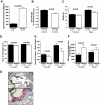Maternal low-protein diet or hypercholesterolemia reduces circulating essential amino acids and leads to intrauterine growth restriction
- PMID: 19073773
- PMCID: PMC2646054
- DOI: 10.2337/db07-1530
Maternal low-protein diet or hypercholesterolemia reduces circulating essential amino acids and leads to intrauterine growth restriction
Abstract
Objective: We have examined maternal mechanisms for adult-onset glucose intolerance, increased adiposity, and atherosclerosis using two mouse models for intrauterine growth restriction (IUGR): maternal protein restriction and hypercholesterolemia.
Research design and methods: For these studies, we measured the amino acid levels in dams from two mouse models for IUGR: 1) feeding C57BL/6J dams a protein-restricted diet and 2) feeding C57BL/6J LDL receptor-null (LDLR(-/-)) dams a high-fat (Western) diet.
Results: Both protein-restricted and hypercholesterolemic dams exhibited significantly decreased concentrations of the essential amino acid phenylalanine and the essential branched chain amino acids leucine, isoleucine, and valine. The protein-restricted diet for pregnant dams resulted in litters with significant IUGR. Protein-restricted male offspring exhibited catch-up growth by 8 weeks of age and developed increased adiposity and glucose intolerance by 32 weeks of age. LDLR(-/-) pregnant dams on a Western diet also had litters with significant IUGR. Male and female LDLR(-/-) Western-diet offspring developed significantly larger atherosclerotic lesions by 90 days compared with chow-diet offspring.
Conclusions: In two mouse models of IUGR, we found reduced concentrations of essential amino acids in the experimental dams. This indicated that shared mechanisms may underlie the phenotypic effects of maternal hypercholesterolemia and maternal protein restriction on the offspring.
Figures



References
-
- Shrimpton R: Preventing low birthweight and reduction of child mortality. Trans R Soc Trop Med Hyg 97: 39–42, 2003 - PubMed
-
- Barker DJ, Osmond C: Infant mortality, childhood nutrition, and ischaemic heart disease in England and Wales. Lancet 1: 1077–1081, 1986 - PubMed
-
- Godfrey KM, Barker DJ: Fetal nutrition and adult disease. Am J Clin Nutr 71: 1344S–1352S, 2000 - PubMed
-
- Hales CN, Barker DJ: Type 2 (non-insulin-dependent) diabetes mellitus: the thrifty phenotype hypothesis. Diabetologia 35: 595–601, 1992 - PubMed
Publication types
MeSH terms
Substances
Grants and funding
LinkOut - more resources
Full Text Sources
Medical
Molecular Biology Databases

